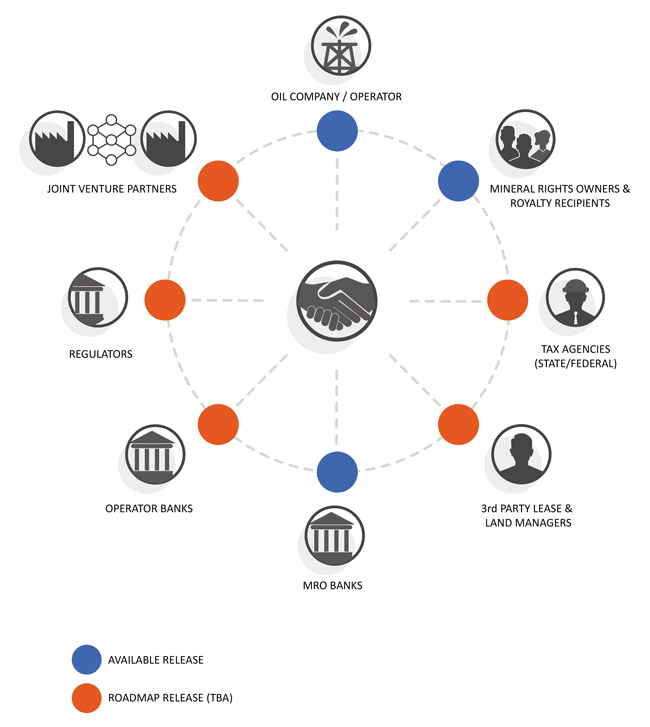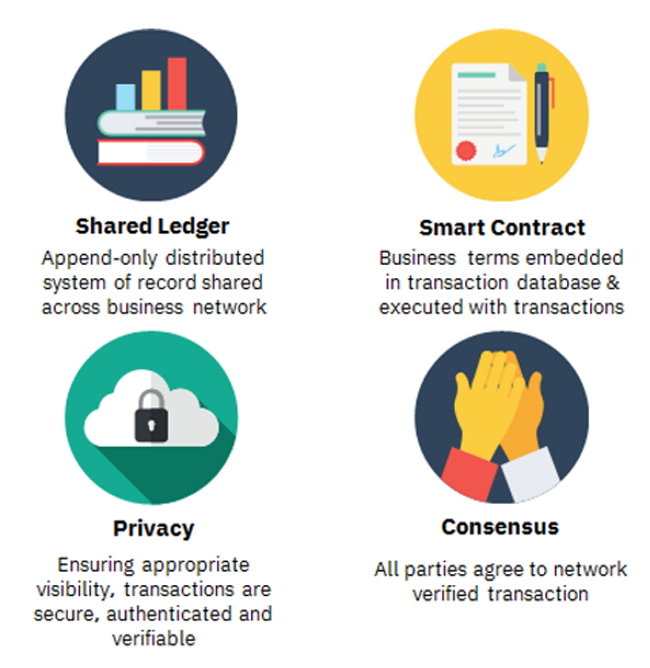
Blockchain Eases Royalty Payments
By Christopher H. Smith, Todd Cooper and JB Sloan
Distributing accurate payments to mineral and royalty owners, joint venture partners and other stakeholders in a well is essential to an operator’s reputation and legitimacy.
Given how many stakeholders each well can have and how much those stakeholders vary from well to well, the workflows for calculating payments can be labor-intensive and error prone. Usually, data related to financial payments passes through multiple systems and often third-party data processors before reaching mineral rights owners. This lengthy journey presents enough opportunities for mistakes that payment disputes are common, and when they occur, they can be expensive to resolve.
Also, more than half of all royalty payments are issued by paper checks. Printing and shipping checks adds extra costs and delays to payment, as well as more points of failure. The checks occasionally get lost in the mail or buried under a pile of life-changing credit card offers.
There is a better way. By implementing smart contracts with distributed ledgers, operators can replace today’s inefficient processes for handling payments, billings, statements and reports with one that is fast, reliable and transparent.
By using smart contracts and distributed ledgers to automate payments, well operators can simultaneously save money and improve their relationships with stakeholders.
This modern process can be implemented through a platform that leverages blockchain technology to provide a unified source of truth for all stakeholders associated with individual wells. With this platform, an oil or gas company can record the production volume, sales volume and price from a well and issue division orders, which interest owners then confirm.
Once the interest owners have verified the division order’s accuracy, a smart contract representing the terms agreed to in the division order is established on a distributed ledger, which records transactions and executes payments according to the terms. The digitally shared ledger is updated and validated with each transaction, resulting in a secure, permanently recorded exchange.
It takes only seconds for the ledger to record a transaction and execute a payment. Compared with filling out, sending and tracking individual paper checks, settlement is lightning-fast and extremely reliable. Because each transaction is validated and stored on the ledger, the results are transparent and trustworthy.
Owner Relations
The smart contract platform significantly reduces the cost of owner relations. Every month, the platform automatically downloads production data from the wells it monitors, then integrates that production data and shares it with the appropriate parties. This eliminates the need for manual data collection, report creation and distribution.
If an interest owner wants to know how a well is performing, they can log into a customized Web portal to see revenue and other expenses. If they have any questions, they can contact the operator through the platform, where it will be easy for the owner to look at relevant information and respond accurately. This reduces the number of calls the operator needs to field and can be more convenient for the interest owner.
The same portal takes care of change of address notifications and other owner-related maintenance.
The system automatically determines revenue and expense sharing among joint venture partners, and it has the technical foundation needed to generate annual tax reports for payees and to send monthly tax reports to state and federal entities. Overall, the system reduces the cost of owner relations, eliminates redundant reports and increases efficiencies between the well operator and various stakeholders.
These benefits can add up to tremendous savings. In fact, one chief information officer told us moving royalty payments to blockchain-based smart contracts would save the industry millions of dollars a year in data and software licensing costs and employee labor; improve data security and quality; and streamline reporting obligations.
Successful Track Record
One of the platform’s early adopters is Zavanna Energy LLC, a community-oriented independent with more than 125 active oil and gas wells in North Dakota and Wyoming. To avoid any chance of disrupting royalty payments, Zavanna operated the platform in parallel with its manual reporting systems for several months. This testing confirmed that the platform’s data handling and reporting functions worked well.
During this phase, Zavanna has seen significant reductions in the amount of time employees spend on owner relations and the overall costs associated with that function. In fact, the company cut processing costs for each royalty check in half.
At the same time, Zavanna received praise from mineral owners for its transparency. Mineral owners also appreciated the platform’s security and ease of use.
The Underlying Technology
To record and validate each transaction, the platform uses blockchain. At its core, blockchain is a type of database. A simple database, such as an Excel spreadsheet, makes searching and filtering data easy for a single user. More extensive databases are installed on servers that have high computing power and can accept connections from hundreds or even thousands of computers in order to provide information to many users simultaneously. Usually, a single database administrator controls the entire computational system.
Blockchain-based systems excel at streamlining transactions that involve multiple parties who have competing interests because the systems create a shared ledger that no single party controls. Before new transactions can be added to that ledger, they are verified by the other parties.
Blockchain structures data differently. The data is organized into groupings called “blocks” that hold a finite amount of information. When a block is filled, a new block is “chained” with the previous block to form a “blockchain,” and the process continues. Instead of storing data in a series of tables, blockchain systems put data in interconnected blocks. That data can be in many forms, such as contracts, product inventory, bank transactions, medical records, property records and supply chain records.
Unlike a conventional database, individual blocks can be stored apart from each other. Most importantly, there is an irreversible timeline attached to the blockchain. A filled block is permanently closed and written on the timeline.
The attraction of blockchain technology is that the required computational power and storage capacity may be distributed to a system of peer-to-peer computers (nodes) located across the globe. For example, in a financial system like the platform for handling royalty payments, once a transaction is determined to be legitimate, the data is clustered into one or more new blocks and timestamped. These blocks are then permanently chained to related transactional data, and the completed transaction is stored on a node.
If an error occurs at a node, intentionally or unintentionally, all the other nodes cross-reference each other, and incorrect data on that node is rejected. This cross-referencing is one of the main reasons blockchain-based systems can be trusted even in situations where the involved parties have incentives to fudge numbers.
Once data has been validated and a block is closed, it cannot be altered. This immutability creates a shared digital ledger that is secure, valid and up to date, and that stores transactions permanently. The result is faster, auditable transactions that are visible to all concerned parties.
Huge Impact
Like personal computers, email and cell phones, blockchain will disrupt how consumers, industries and businesses operate. Its applications go far beyond cryptocurrency. Outside the oil and gas industry, it has been used to securely share medical data, monitor and manage complex supply chains, process real estate transactions, manage rights for music and other art, and provide a secure but efficient way for publicly traded companies to handle proxy votes.
Blockchain is worth considering for any application that requires a secure and transparent database and involves multiple parties. In oil and gas, handling royalty payments is but one of many use cases. In fact, Blockchain for Energy–a consortium that includes Chevron, ConocoPhillips, Hess, ExxonMobil, Pioneer Natural Resources and Repsol–has successfully tested blockchain-based systems for monitoring and paying produced water haulers. It also has deployed blockchains to speed balloting for authorizations for expenditure.
Because blockchain systems can simplify so many processes, companies as large and respected as IBM are developing infrastructure and software to support it. As that infrastructure grows and the number of blockchain experts rises, the costs and time required to deploy blockchain will shrink. The technology is already an effective way for producers, service companies and midstream firms to reduce operating costs and improve relationships with business partners, and it is only going to get better.
Editor’s Note: The authors are hosting a webinar on Dec. 15 that will explore in greater detail blockchain’s ability to streamline royalty payments and joint interest billing.

CHRISTOPHER H. SMITH is the executive vice president of business development for the energy division of NuArca, a provider of blockchain-based platforms for automating transactions and other multiparty decisions. Smith has more than 25 years of experience in the oil and gas industry, including leading acquisitions, operations and information/software systems for USA Petroleum, Tricon Energy, IHS EnergyData and Oracle Energy.

TODD COOPER is the chief executive officer and co-founder of NuArca. He has more than 20 years’ experience leading and managing high-growth financial technology businesses. During his career, he has focused on helping tier one, global financial services firms manage risk and meet their regulatory obligations.

JB SLOAN is the executive vice president of product management for NuArca. He joined the company from Pegasystems, where he served as product manager for sales automation and customer service solutions designed for financial services. As part of this role, he managed the development and launch of the customer service chatbot solution for Facebook Message. In total, he has 15 years of product management experience in the financial services sector, including work for many of the world’s top 50 banks.
For other great articles about exploration, drilling, completions and production, subscribe to The American Oil & Gas Reporter and bookmark www.aogr.com.








